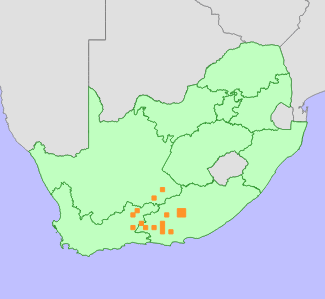|
Scientific Name | Orbea miscella (N.E.Br.) Meve |
Higher Classification | Dicotyledons |
Family | APOCYNACEAE |
Synonyms | Angolluma miscella (N.E.Br.) Plowes, Caralluma bredae R.A.Dyer (in part), Caralluma bredae R.A.Dyer var. bredae, Caralluma bredae R.A.Dyer var. thomallae R.A.Dyer, Pachycymbium miscellum (N.E.Br.) M.G.Gilbert, Stapelia miscella N.E.Br., Stultitia miscella (N.E.Br.) C.A.Lückh. |
National Status |
Status and Criteria | Least Concern |
Assessment Date | 2019/11/04 |
Assessor(s) | D. Raimondo |
Justification | Orbea miscella is a widespread but poorly sampled species from the Great Karoo with an extent of occurrence (EOO) of 54 258 km². It is not currently threatened and is therefore listed as Least Concern. |
Distribution |
Endemism | South African endemic |
Provincial distribution | Eastern Cape, Northern Cape, Western Cape |
Range | This species is endemic to South Africa. It is widespread across the Great Karoo, from Fraserburg north-eastwards to Richmond, Hanover and Cradock and south-eastwards to Willowmore and Steytlerville. |
Habitat and Ecology |
Major system | Terrestrial |
Major habitats | Steytlerville Karoo, Prince Albert Succulent Karoo, Eastern Upper Karoo, Northern Upper Karoo, Eastern Lower Karoo, Gamka Karoo, Karoo Escarpment Grassland, Willowmore Gwarrieveld, Baviaans Valley Thicket |
Description | It grows in sheltered places among stones and small karroid shrubs on flats and low stony ridges. |
Threats |
| There are currently no severe threats to Orbea miscella. Its distribution range falls largely within an area earmarked for shale gas extraction. It could potentially decline significantly in future, should planned large scale gas extraction go ahead. A Strategic Environmental Impact Assessment submitted to South Africa's Department of Environmental Affairs in 2016 cautioned against moving ahead with Shale Gas fracking based on the very high infrastructure costs associated with fracking as well as multiple secondary negative impacts both to biodiversity and other economic activities in the region. Furthermore geological studies that have taken place since 2016 have found that gas deposits are not as substantial as originally suspected due to the very old age of the Karroo shale formations and due to the dolerite intrusions that occur throughout the Karoo having resulted in much of the gas being lost. At present, future development scenarios are too uncertain to estimate the potential extent of the impact on the population but it is unlikely that shale gas fracking will proceed in the near future. |
Population |
This species is a widespread species, but known from only a few, scattered collections. Plants are easily overlooked, as they are inconspicuous and typically occur hidden underneath karroid shrubs. In addition, its distribution range is botanically relatively poorly explored, and most of its habitat remains intact. Therefore, it is highly likely to be more common than records suggest. There are no current severe threats to this species and therefore the population is not suspected to be declining.
|
Population trend | Stable |
Assessment History |
Taxon assessed |
Status and Criteria |
Citation/Red List version | | Orbea miscella (N.E.Br.) Meve | Least Concern | Raimondo et al. (2009) | | Pachycymbium miscellum (N.E.Br.) M.G.Gilbert | Not Threatened | Hilton-Taylor (1996) | | Caralluma bredae R.A.Dyer var. thomallae R.A.Dyer | Indeterminate | Hall et al. (1980) | | Caralluma bredae R.A.Dyer var. bredae | Rare | Hall et al. (1980) | |
Bibliography |
Bruyns, P.V. 2005. Stapeliads of southern Africa and Madagascar. (Vol. 1, pp. 1-330). Umdaus Press, Pretoria.
Hall, A.V., De Winter, M., De Winter, B. and Van Oosterhout, S.A.M. 1980. Threatened plants of southern Africa. South African National Scienctific Programmes Report 45. CSIR, Pretoria.
Hilton-Taylor, C. 1996. Red data list of southern African plants. Strelitzia 4. South African National Botanical Institute, Pretoria.
Raimondo, D., von Staden, L., Foden, W., Victor, J.E., Helme, N.A., Turner, R.C., Kamundi, D.A. and Manyama, P.A. 2009. Red List of South African Plants. Strelitzia 25. South African National Biodiversity Institute, Pretoria.
Snijman, D.A. 2013. Plants of the Greater Cape Floristic Region 2: The extra Cape flora. Strelitzia 30. South African National Biodiversity Institute, Pretoria.
|
Citation |
| Raimondo, D. 2019. Orbea miscella (N.E.Br.) Meve. National Assessment: Red List of South African Plants version 2024.1. Accessed on 2025/11/26 |
 Comment on this assessment
Comment on this assessment


